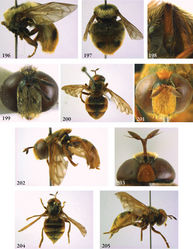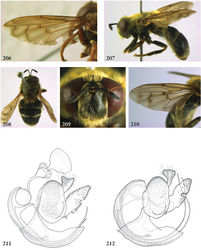Microdon hauseri
| Notice: | This page is derived from the original publication listed below, whose author(s) should always be credited. Further contributors may edit and improve the content of this page and, consequently, need to be credited as well (see page history). Any assessment of factual correctness requires a careful review of the original article as well as of subsequent contributions.
If you are uncertain whether your planned contribution is correct or not, we suggest that you use the associated discussion page instead of editing the page directly. This page should be cited as follows (rationale):
Citation formats to copy and paste
BibTeX: @article{Reemer2013ZooKeys288, RIS/ Endnote: TY - JOUR Wikipedia/ Citizendium: <ref name="Reemer2013ZooKeys288">{{Citation See also the citation download page at the journal. |
Ordo: Diptera
Familia: Syrphidae
Genus: Microdon
Name
Microdon hauseri Reemer sp. n. – Wikispecies link – ZooBank link – Pensoft Profile
Type specimens
HOLOTYPE. Adult male. CHINA. Label 1: “Yunnan. Tengchong / 50 km NNW: Houqiao / N25.388° E 98.211° / 1700 m / 01.VI.2009 leg. / Blank, Liston, Taeger / 008 China”; label 2: “Voucher code M. Reemer / 302 / DNA voucher labcode MZH:Y1096”. Coll. CSCS.
Diagnosis
In the keys of Shiraki (1968)[1], Huo et al. (2007)[2] and – depending on how characters are interpreted – Hironaga and Maruyama (2004)[3], this species keys to Microdon auricomus Coquillet, 1898, from which it differs by the largely orange legs and the long, orange-golden pilosity on the anterodorsal part of the hind femur. These characters also apply for distinguishing Microdon hauseri sp. n. from Microdon murayamai Hironaga & Maruyama, 2004, to which specimens of the species will key in the key of Hironaga and Maruyama (2004)[3]. The same characters apply for separating it from Microdon lateus Violovitsh, 1975, to which it keys using Violovitsh (1983)[4]. In the key of Shiraki (1930)[5] this species keys to Microdon formosanus Shiraki, 1930, from which it differs by the black pilosity medially on the mesoscutum (entirely pale in Microdon formosanus).
Description (based on holotype)
Adult male. Body size: 12.5 mm.
Head. Face occupying about 1/3 of head width in frontal view; black; entirely yellowish pilose. Gena black, yellowish pilose. Oral margin not produced. Frons black; black pilose, except narrowly yellow pilose along lateral and posterior margins. Vertex black; black pilose, except narrowly yellow pilose along all margins. Occiput black; yellow pilose. Eye bare. Antennal fossa about as high as wide. Antenna black; antennal ratio approximately as 3.5:1:2.5.
Thorax. Entire thorax blackish with bronze hues. Mesoscutum black pilose medially, widely yellow pilose along margins. Postpronotum, postalar callus and scutellum yellow pilose. Scutellum trapezoid with slightly concave posterior margin; without calcars. Anepisternum yellow pilose anteriorly, mixed black and yellow pilose posteriorly, with widely bare part in between; with shallow sulcus separating anterior from posterior part. Anepimeron entirely yellow pilose. Katepisternum yellow pilose dorsally, very sparsely yellow pilose ventrally. Katatergum long microtrichose, anatergum short microtrichose. Calypter and halter pale yellow.
Wing: Hyaline, subtly darkened around apical crossveins; microtrichose, except bare on basal 3/5 of cell br and basomedian 1/3 of alula.
Legs: Orange, except basal 1/4 of femora blackish, apex of femora narrowly darkened and tibiae dorsally darkened. Front femur black pilose, except for patch of orange-golden pile anterobasally; mid femur orange-golden pilose anteriorly and posteriorly on basal 2/3, with patch of orange-golden pile anteroventrally on basal 1/4, black pilose dorsally and ventrally; hind femur with long orange-golden pile anterodorsally and posteriorly, with orange-golden pile on basal 1/3, black pilose otherwise. Front and mid tibia orange-golden pilose, except black pilose dorsally. Hind tibia orange-golden pilose (long dorsally, short ventrally), except black pilose laterally. Tarsi black pilose. Coxae and trochanters black; pale pilose.
Abdomen. Tergites black with bronze hues. Tergites 1 and 2 golden pilose. Tergite 3 golden pilose on lateral 1/4, orange-golden pilose medially (colour transition gradual). Tergite 4 orange-golden pilose, except for pair of submedian patches of black pile on anterior 1/2; each about as wide as 1/4 of the tergite. Sternites black with bronze hues; entirely whitish to golden pilose. Male genitalia as in Fig. 212.
Female. Unknown.
Etymology
This species is named after Martin Hauser, in acknowledgement for the many interesting specimens of Microdontinae he sent to the author. The epithet is a noun in the genitive case.
Original Description
- Reemer, M; Ståhls, G; 2013: Generic revision and species classification of the Microdontinae (Diptera, Syrphidae) ZooKeys, 288: 1-213. doi
Other References
- ↑ Shiraki T (1968) Fauna Japonica. Syrphidae (Insecta: Diptera). Volume II. Biogeographical Society of Japan, Tokyo, 243 pp.
- ↑ Huo K, Ren G, Zheng Z (2007) Fauna of Syrphidae from Mt. Qinling-Bashan in China (Insecta: Diptera). China Agricultural Press, Bejing, 512 pp. [Chinese with English summary and keys]
- ↑ 3.0 3.1 Hironaga T, Maruyama M (2004) The myrmecophilous hoverfly genus Microdon (Diptera, Syrphidae, Microdontinae) in Hokkaido, Japan, with descriptions of four new species. Bulletin of the National Science Museum, Tokyo Serie A 30: 87-103.
- ↑ Violovitsh N (1983) Siberian Syrphidae (Diptera). Verslagen en Technische Gegevens van het Instituut voor Taxonomische Zoölogie, Universiteit van Amsterdam 43: 1–228. [English translation from Russian by V.S. van der Goot and L. Verlinden, March 1986]
- ↑ Shiraki T (1930) Die Syrphiden des Japanischen Kaiserreichs, mit berücksichtigung benachbarter Gebiete. Memoirs of the Faculty of Science and Agriculture, Taihoku Imperial University 1: 1-446.
Images
|

